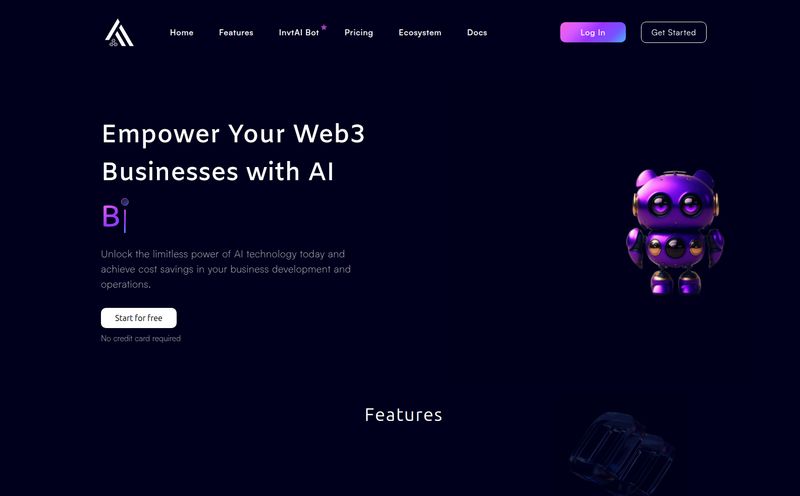If you're in marketing, customer support, or pretty much any business role today, your screen probably looks like a digital version of a spy’s multi-monitor setup. You’ve got a tab for WhatsApp Web, another for Facebook Messenger, your site’s live chat is dinging, and you’re trying to manage SMS notifications. It's a mess. A total API-Gordian-Knot that we're all just trying to keep from collapsing.
For years, the dream has been a single dashboard. A master key. One platform to rule them all. I’ve seen countless companies promise it, and frankly, I've gotten a little jaded. But every now and then, a platform pops up that makes me lean in a little closer. Today, that platform is UIB.
Their tagline is “Simply Communicate.” A bold claim in a world where communication is anything but simple. So, is it just another drop in the ocean of SaaS promises, or is there something more here?
So, What is UIB, Really?
On the surface, UIB is an omnichannel messaging and conversational AI platform. Okay, buzzwords. Let's translate that from marketing-speak into human. Imagine you have a fantastic, highly-trained switchboard operator from the 1950s. They know exactly how to connect any call to any extension, no matter the technology. Now, imagine that operator works with WhatsApp, Telegram, SMS, web chat, voice assistants, and probably even signals from your smart fridge. That's the core idea of UIB.
It’s designed to be the central hub that connects your business to your customers, wherever they are. It’s not just about having multiple channels available—that's multichannel. It’s about creating one, continuous conversation that can move between those channels. That's the omnichannel promise, and it's a difference that actually matters for customer experience.
The Tech Under the Hood
UIB isn’t just one thing; it's a combination of a few clever pieces of technology working together. Let’s pop the hood.
UnificationEngine®: The Universal Translator
This is the heart of the operation. The UnificationEngine® is UIB’s single API platform. For the non-devs in the room, an API is basically how different software programs talk to each other. Normally, if you want to connect to WhatsApp, you need its specific API. For Facebook, another API. For Twilio SMS, yet another. It's a nightmare to build and maintain.
UIB’s engine acts like a universal translator. You connect to their one API, and they handle the connections to all the other platforms. This is huge. It means your developers can build one set of logic for sending a notification, and UIB figures out whether it should go out as a text, a WhatsApp message, or a carrier pigeon (okay, maybe not the last one).
Unified AI®: Your AI, Your Way
Here’s where it gets really interesting for me. UIB offers a conversational AI platform, but it’s NLP-agnostic. NLP, or Natural Language Processing, is the brain that understands what a user is typing. Big players have their own, like Google’s Dialogflow or Amazon's Lex.
Being NLP-agnostic means UIB doesn't force you to use their brain. Got a chatbot you’ve already spent months training on another platform? You can often plug it right into UIB’s system. This is a breath of fresh air. It lets you use best-in-class tools without being locked into one company's entire ecosystem. They also offer white-label solutions, which is a big plus for agencies building solutions for their clients.
H2X® Exchange: The Connectivity Marketplace
Think of the H2X® Exchange as UIB's app store. It’s a marketplace of pre-built connectors to other cloud services and even IoT devices. This is where the platform shows its ambition—it’s not just about person-to-person chat, but connecting systems. You could theoretically have a customer ask a chatbot about their order, and UIB could use a connector to check your Shopify store’s backend for the status. That's powerful stuff.
The Million-Dollar Question: What's the Price?
Alright, let's talk about the elephant in the room. For the longest time, UIB's site had that dreaded “Contact Us for Pricing” button. It’s a personal pet peeve of mine; it just feels like you're about to get into a long sales process when you just want a ballpark number. It seems like they’ve listened, though, because their site now shows a pretty clear tiered structure. A welcome change!

Visit UIB
Here’s a quick breakdown of what they're showing now:
| Plan | Price | Key Feature |
|---|---|---|
| Free | $0 / month | Good for 3 months to test things out. |
| Standard | $30 / month | A solid starting point for small to medium businesses. |
| Premium | $50 / month | Best value, designed for scaling with more benefits. |
Note: The descriptions in the image are a bit generic ("Use this area to describe one of your memberships"), so you'd still want to click through or chat with them to understand the exact limits on messages or users for each tier. But hey, it's a start! Seeing actual prices is a huge step towards transparency.
The Good, The Bad, and The API-Dependent
No tool is perfect, right? After digging in, here's my take.
The biggest advantage is definitely the unified API. It's a developer's dream and a business's solution to future-proofing. When the next big messaging app comes along, you can bet UIB will just add it as a new channel, and your existing setup will just work. The flexibility of the NLP-agnostic AI builder is a close second. It shows they understand that businesses have already invested in other tools.
On the flip side, to really get the most out of this, you’ll likely need some technical know-how, or a developer on hand. While they might have user-friendly interfaces, the real power is in that API, and APIs mean code. Also, by using a platform like this, you are putting a lot of your communication eggs in one basket. You're reliant on UIB’s platform to be up and running. It’s a trade-off: simplicity for a degree of dependency. For most businesses, I'd argue it's a trade-off worth considering.
So, Is UIB the Answer?
If you're a small business owner just using Facebook Messenger to chat with a few customers a day, UIB is probably overkill. But if you’re a growing business in e-commerce, healthcare, finance, or logistics, and you feel that pain of fragmented customer conversations... this could be it. This could be the thing that simplifies your stack, delights your customers, and lets your team focus on the conversation, not the platform it’s on.
It’s an ambitious platform that seems to have the right ideas about the future of communication: unified, flexible, and intelligent. It's one I'll be keeping a close eye on.
Frequently Asked Questions
- What is an omnichannel messaging platform?
- It's a system that unifies multiple communication channels (like SMS, WhatsApp, web chat) into a single, continuous conversation. A customer can start a chat on your website and pick it up later on their phone via WhatsApp without losing context.
- Is UIB just another chatbot builder?
- No, it's more of a foundation. It includes a conversational AI builder (Unified AI®), but its main function is to connect all your communication channels together. You can run chatbots on it, but you can also use it for simple notifications or human-to-human chats.
- What does 'NLP-agnostic' mean for UIB?
- It means you're not locked into using UIB's proprietary Natural Language Processing technology. You can integrate AI models from other providers like Google, Amazon, or Microsoft, giving you more flexibility and control over your chatbot's intelligence.
- Can I really use my own AI with UIB?
- Yes, that's one of its main selling points. The UnificationEngine® is designed to be an integration platform, allowing you to plug in third-party AI and NLP services.
- What kind of businesses benefit most from UIB?
- Businesses that communicate with customers across multiple channels and at scale. The footer on their site lists industries like Automotive, eCommerce, Finance, Healthcare, and Logistics, which all rely heavily on timely, multi-channel notifications and support.
Final Thoughts
The quest for the perfect communication stack is a long one, and there’s no single silver bullet. But UIB makes a compelling case. By focusing on unification and flexibility rather than trying to build a closed-off, walled garden, they’re positioning themselves as a powerful enabler. They're not just giving you a tool; they’re giving you a switchboard for the entire digital world. And in today's chaotic market, that kind of clarity is worth a lot.



